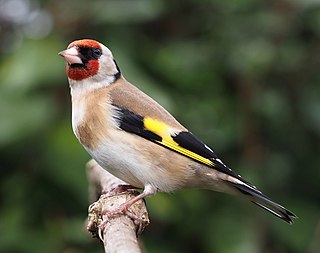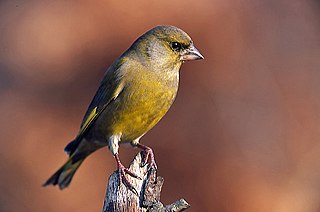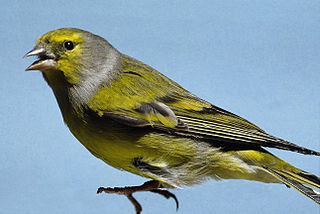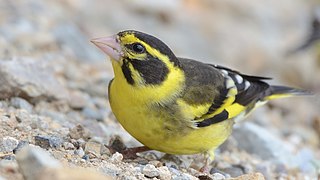
The true finches are small to medium-sized passerine birds in the family Fringillidae. Finches generally have stout conical bills adapted for eating seeds and nuts and often have colourful plumage. They occupy a great range of habitats where they are usually resident and do not migrate. They have a worldwide native distribution except for Australia and the polar regions. The family Fringillidae contains more than two hundred species divided into fifty genera. It includes the canaries, siskins, redpolls, serins, grosbeaks and euphonias, as well as the morphologically divergent Hawaiian honeycreepers.

The European goldfinch or simply the goldfinch is a small passerine bird in the finch family that is native to Europe, North Africa and western and central Asia. It has been introduced to other areas, including Australia, New Zealand and Uruguay.

The Eurasian chaffinch, common chaffinch, or simply the chaffinch is a common and widespread small passerine bird in the finch family. The male is brightly coloured with a blue-grey cap and rust-red underparts. The female is more subdued in colouring, but both sexes have two contrasting white wing bars and white sides to the tail. The male bird has a strong voice and sings from exposed perches to attract a mate.

The genus Carduelis is a group of birds in the finch family Fringillidae.

Crossbills are birds of the genus Loxia within the finch family (Fringillidae), with six species. These birds are characterized by the mandibles with crossed tips, which gives the group its English name. Adult males tend to be red or orange in color, and females green or yellow, but there is much variation.

The common reed bunting is a passerine bird in the bunting family Emberizidae, a group now separated by most modern authors from the finches, Fringillidae. The genus name Emberiza is from Old German Embritz, a bunting. The specific schoeniclus is from Ancient Greek skhoiniklos, a now unknown waterside bird.

The European greenfinch or simply the greenfinch is a small passerine bird in the finch family Fringillidae.

The redpolls are a group of small passerine birds in the finch family Fringillidae, which have characteristic red markings on their heads. They are placed in the genus Acanthis. The genus name Acanthis is from the Ancient Greek akanthis, a name for a small now unidentifiable bird.

The common redpoll or mealy redpoll is a species of bird in the finch family. It breeds somewhat further south than the Arctic redpoll, also in habitats with thickets or shrubs.

The common linnet is a small passerine bird of the finch family, Fringillidae. It derives its common name and the scientific name, Linaria, from its fondness for hemp seeds and flax seeds—flax being the English name of the plant from which linen is made.

The hawfinch is a passerine bird in the finch family Fringillidae. It is the only species placed in the genus Coccothraustes. Its closest living relatives are the Chinese grosbeak and Japanese grosbeak of East Asia, and the evening grosbeak and hooded grosbeak of North America.

The purple finch is a bird in the finch family, Fringillidae. It breeds in the northern United States, southern Canada, and the west coast of North America.

The pine grosbeak is a large member of the true finch family, Fringillidae. It is the only species in the genus Pinicola. It is found in coniferous woods across Alaska, the western mountains of the United States, Canada, and in subarctic Fennoscandia and across the Palearctic to Siberia. The species is a frugivore, especially in winter, favoring small fruits, such as rowans. With fruit-crop abundance varying from year to year, pine grosbeak is one of many subarctic-resident bird species that exhibit irruptive behavior. In irruption years, individuals can move long distances in search of suitable food supplies, bringing them farther south and/or downslope than is typical of years with large fruit crops.

The citril finch, also known as the Alpine citril finch, is a small songbird, a member of the true finch family, Fringillidae.

The grey-capped greenfinch or Oriental greenfinch is a small passerine bird in the finch family Fringillidae that breeds in broadleaf and conifer woodlands of the East Palearctic.

The British finches are made up of several species of finch which were formerly very popular as cage birds in Great Britain. They are not currently commonplace, but are still kept by a few dedicated fanciers.

The Warsangli linnet is a species of finch in the family Fringillidae. It is found only in northeastern Somalia. Its natural habitats are subtropical or tropical dry forest and subtropical or tropical high-altitude shrubland. It is threatened by habitat loss.

The yellow-breasted greenfinch is a small passerine bird in the family Fringillidae that is native to the northern regions of the Indian subcontinent.

The Yemen linnet is a species of finch in the family Fringillidae. It is found in Saudi Arabia and Yemen. Its natural habitat is subtropical or tropical dry shrubland.

Linaria is a genus of small passerine birds in the finch family (Fringillidae) that contains the twite and the linnets. The genus name linaria is the Latin for a linen-weaver, from linum, "flax".























